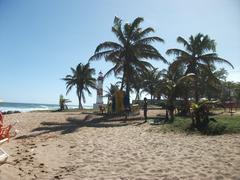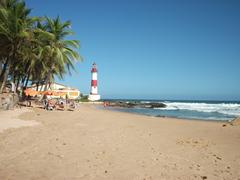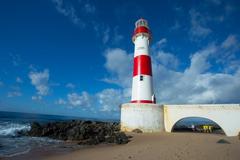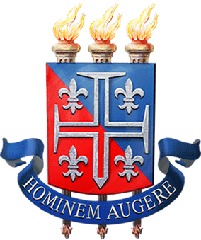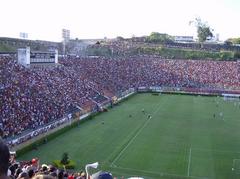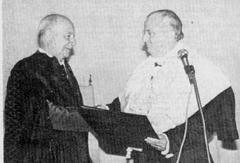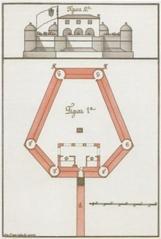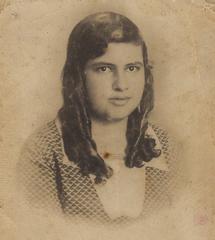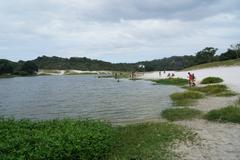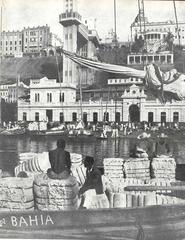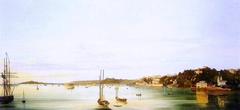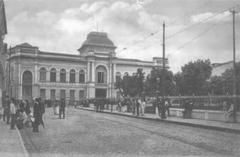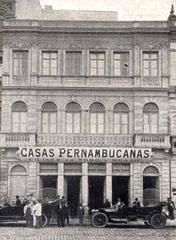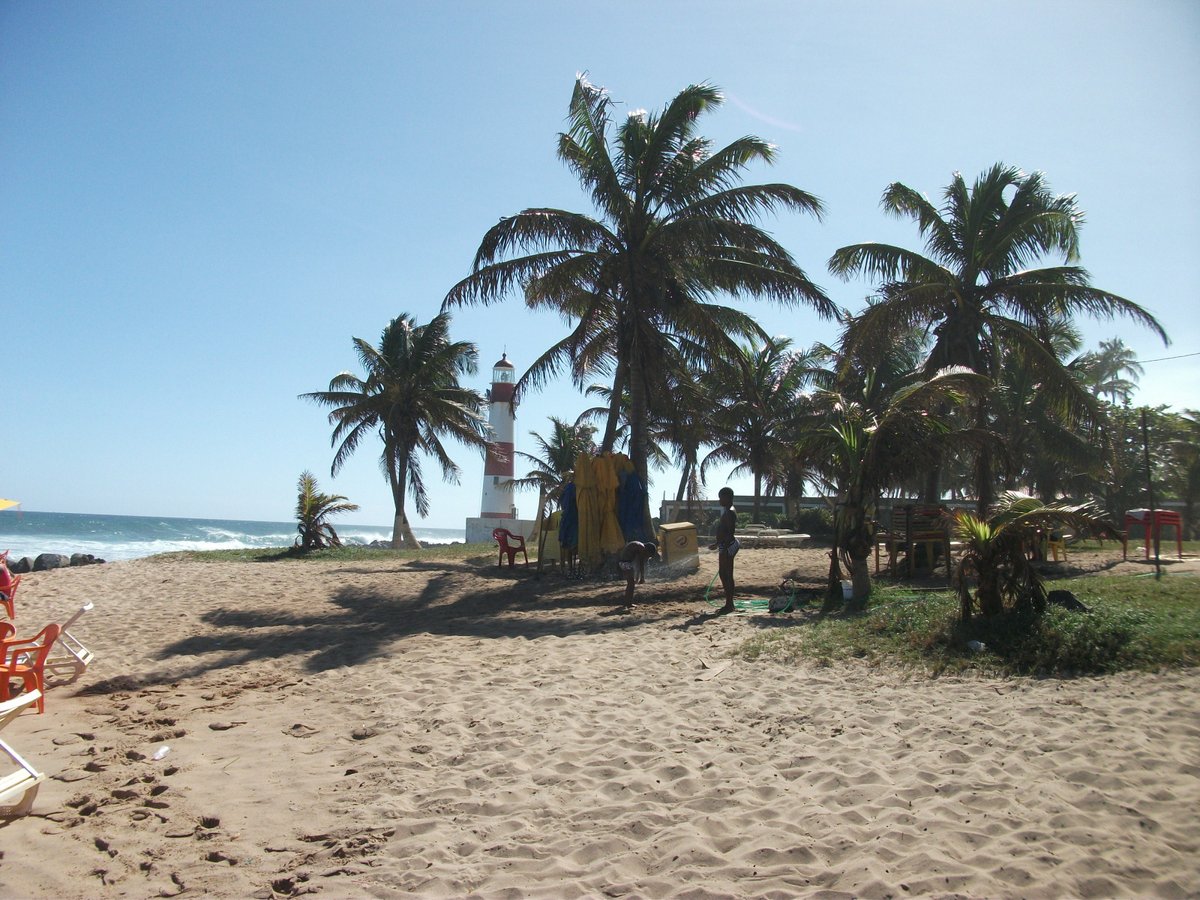
Visiting Itapuã Lighthouse: Hours, Tickets, and Nearby Attractions in Salvador, Brazil
Publication Date: 16/08/2024
Introduction to Itapuã Lighthouse
The Itapuã Lighthouse, or Farol de Itapuã as it is locally known, is a prominent historical landmark in Salvador, Bahia, Brazil. Constructed in 1873, this iconic lighthouse was initially built to alert maritime vessels of the perilous sandbanks near the Bahian coast, thus playing a critical role in safe navigation (Forbes). Its cylindrical tower, adorned with striking red and white bands, stands as a testament to 19th-century architectural design and engineering prowess. Beyond its functional purpose, the lighthouse has also become a cultural symbol, inspiring local folklore, art, and literature. Today, it continues to attract visitors from around the world, offering a unique blend of historical significance and natural beauty. This guide aims to provide comprehensive information on the Itapuã Lighthouse’s history, visitor tips, nearby attractions, and practical travel advice, ensuring a memorable visit to this captivating destination.
Table of Contents for Visiting Itapuã Lighthouse
- Exploring the Itapuã Lighthouse: History, Visitor Tips, and Nearby Attractions
- Introduction
- Construction and Early Years
- Architectural Design
- Operational Significance
- Historical Context
- Cultural Impact
- Modern-Day Relevance
- Preservation Efforts
- Visitor Experience
- Visiting Hours and Tickets
- Nearby Attractions
- FAQ
- Conclusion
Exploring the Itapuã Lighthouse: History, Visitor Tips, and Nearby Attractions
Introduction
The Itapuã Lighthouse, known locally as Farol de Itapuã, is a significant historical beacon in Salvador, Bahia, Brazil. This lighthouse is not just a navigational aid but a cultural landmark that draws visitors from around the world. In this article, we will delve into its rich history, architectural design, and operational significance, and provide practical visitor tips and information on nearby attractions. Whether you’re a history buff, a photography enthusiast, or simply looking to enjoy the scenic beauty of the Bahian coast, the Itapuã Lighthouse offers a unique and enriching experience.
Construction and Early Years
Constructed in 1873, the Itapuã Lighthouse was built in the Pedra da Piraboca area to warn ships of the treacherous sandbanks that posed a significant threat to maritime navigation along the Bahian coast (Forbes). The 21-meter (approximately 70 feet) tall structure was a critical addition to the coastal safety measures of the time, ensuring that vessels could navigate the waters safely.
Architectural Design
The Itapuã Lighthouse is an exemplary model of 19th-century lighthouse architecture. Its cylindrical tower, painted in distinctive red and white bands, is not only functional but also aesthetically pleasing. The design was intended to make the lighthouse easily recognizable during both day and night. The structure’s robust build has allowed it to withstand the harsh coastal weather conditions for over a century.
Operational Significance
Initially, the lighthouse was manned by resident keepers who ensured that the light was operational every night. The light source, originally an oil lamp, was later upgraded to more modern lighting technologies as advancements were made. The lighthouse’s primary function was to serve as a navigational aid, warning ships of the dangerous sandbanks and guiding them safely to the port of Salvador, one of the largest ports in Bahia (Ibiblio).
Historical Context
The construction of the Itapuã Lighthouse came at a time when Brazil was undergoing significant changes. Having declared its independence from Portugal in 1822, Brazil was in the process of establishing itself as a sovereign nation. The lighthouse was part of broader efforts to improve the country’s infrastructure and ensure the safety of its maritime activities. During this period, Brazil was still a monarchy, known as the Empire of Brazil, until it became a republic in 1889 (Ibiblio).
Cultural Impact
The Itapuã Lighthouse has been a subject of local folklore and has inspired various works of art and literature. The lighthouse’s picturesque setting has made it a popular subject for photographers and artists alike. Its presence has also contributed to the identity of the Itapuã district, making it a symbol of the area’s rich maritime history.
Modern-Day Relevance
Today, the Itapuã Lighthouse remains an attractive beacon, drawing visitors from around the world. Although the inner area of the lighthouse is not open to the public, its exterior continues to be a popular spot for tourists and locals alike (Live More Travel More). The lighthouse is part of a broader urban renewal plan that has made the coastal areas of Salvador more user-friendly, with boardwalks, kiosks, and various amenities enhancing the visitor experience (Forbes).
Preservation Efforts
The preservation of the Itapuã Lighthouse is managed by the Brazilian Navy, specifically the Centro de Auxílios à Navegação Almirante Moraes Rego (CAMR) under the Diretoria de Hidrografia e Navegação (DHN). These organizations are responsible for maintaining the lighthouse and ensuring that it continues to serve its navigational purpose. Many of the larger lighthouses in Brazil, including Itapuã, are staffed by resident keepers or rotating crews of naval personnel (Ibiblio).
Visitor Experience
While the lighthouse itself is not open for interior tours, the surrounding area offers plenty for visitors to enjoy. The nearby beaches, such as Praia do Itapuã, provide opportunities for swimming, sunbathing, and various water sports. The Lôro beach club, located close to the lighthouse, offers a relaxed environment with seafood dining, massage treatments, and boutique shopping (Forbes).
Visiting Hours and Tickets:
- The Itapuã Lighthouse is not open for public tours inside, but the surrounding area is accessible at all times. There are no entrance fees to visit the exterior of the lighthouse.
Nearby Attractions
In addition to the lighthouse, the Itapuã district is home to several other attractions. The Parque das Dunas, a 1,500-acre protected area, offers guided tours where visitors can explore the unique dune and lagoon ecosystems. The Mar Brasil hotel, which houses the Vina and Gessa Memorial, honors the famous lyricist and actress couple, adding a cultural dimension to the visit (Forbes).
FAQ
What are the visiting hours for the Itapuã Lighthouse?
- The exterior of the lighthouse is accessible at all times.
Are there any tickets required to visit the Itapuã Lighthouse?
- No, there are no entrance fees to visit the exterior of the lighthouse.
What other attractions are nearby?
- Nearby attractions include Praia do Itapuã, Parque das Dunas, and the Mar Brasil hotel.
Conclusion
The Itapuã Lighthouse stands as a testament to Brazil’s rich maritime history and its ongoing efforts to preserve and celebrate its cultural landmarks. Its historical significance, coupled with its modern-day appeal, makes it a must-visit for anyone traveling to Salvador, Bahia. Whether you’re a history buff, a photography enthusiast, or simply looking to enjoy the scenic beauty of the Bahian coast, the Itapuã Lighthouse offers a unique and enriching experience. For more updates and tips, follow us on social media and stay tuned for more articles on historical sites in Salvador.
Summary of Itapuã Lighthouse Visit
The Itapuã Lighthouse is more than just a navigational beacon; it is a cultural and historical gem that encapsulates the rich maritime heritage of Salvador, Bahia. From its initial construction in 1873 to its present-day status as a beloved tourist attraction, the lighthouse has stood the test of time, both structurally and symbolically. Its unique architectural design, historical significance, and cultural impact make it a must-visit landmark for anyone exploring Salvador. Whether you’re interested in maritime history, local folklore, or simply seeking a picturesque spot for photography, the Itapuã Lighthouse offers a diverse and enriching experience. With its free access, guided tour options, and nearby attractions like Praia do Itapuã and Parque das Dunas, visitors can enjoy a well-rounded and memorable outing. For those planning a visit, the information provided in this guide will ensure a safe, enjoyable, and informative experience. Stay tuned for more updates and tips by following us on social media or downloading our mobile app Audiala.
Sources and Further Reading
- Oseid, J. (2021). Discovering a Beachfront Enclave in Salvador, Bahia. Forbes
- Ibiblio. (n.d.). Lights of Brazil. Ibiblio
- Bahia.ws. (n.d.). History of the Forts and Lighthouses of Salvador. Bahia.ws
- Triplyzer. (n.d.). Things to Do in Salvador. Triplyzer
- Live More Travel More. (n.d.). Salvador, Brazil. Live More Travel More
